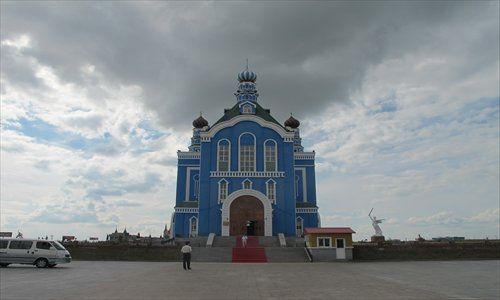
The Russian Art Museum Photos: Xu Liuliu/GT
When thinking of the landscape that lies far north of Beijing, the line "a scene of clear skies, vast grasslands, and cows and sheep that dawn over the grass as the wind blows" must come into your mind. People like me who hail from China's eastern coastal plains, which boast beautiful greenery in their own right, are still enchanted by the idea of a visit to the northern grasslands. A nearly three-hour flight north from Beijing took me to the border city of Manzhouli in northern China's Inner Mongolia Autonomous Region, where China, Russia and Mongolia meet.
Before leaving for the trip, I had hoped to do some homework on the Internet. However, I was disappointed to find no specific advice other than to enjoy Hulunbuir Prairie, one of the most beautiful grasslands in the world.
When I got off the plane, the Russian-style airport reminded me that the city would be full of Russian flavor. The Shangri-La Hotel that I booked even prepared a welcome ceremony for us, very much in the Russian style, presenting a loaf of bread with a salt shaker on top to each guest. As many Russians used to do business in Manzhouli, over the years, many have chosen to spend vacations there, and the tradition has spread.
Little trip on the prairie
Manzhouli is a small city with a population of about 200,000, mostly ethnic Mongolians. A local friend advised us to spend one day exploring the city if our main aim was to see the grasslands. In fact, the city is located in the middle of a vast grassland. Drive in any direction for 20 minutes and you will find yourself surrounded by greenery.
Be sure to rent a car or mini bus for such a trip, as you will travel long distances between different scenic spots.
We set out along the highway to the first stop, the Huhe Nur Grassland Scenic Spot. Through the windows on both sides I looked out on the boundless rolling land. From time to time, we saw cows grazing along the road, and sometimes crossing the street.
It was a pity to see that the vast prairie is no longer one continuous span, but rather divided into small pieces, each owned by herdsman. Our guide said that people wait with their cows to cross the road and then continue their trip. As the local old saying goes, humans have their own road and so do the cows. They know how to go home by walking along the boundary fences.
An introduction to this mysterious land occurred along the way. Enthusiastic discussion on history and culture ensued among us travelers while epic TV dramas of Mongolian hero Genghis Khan aired on the bus. Mongolian songs danced into my ears from passing SUVs. I felt transported, lost in the feeling of a true road trip. Sometimes the most charming part of a trip is the scenery you encounter and the time you spend on the way to the destination.
Most herdsmen no longer live in traditional Mongolian yurts, which can be removed and set up again quickly when families relocate. Because of the booming travel industry, local people have permanently built Mongolian yurts on scenic spots like Huhe Nur for travelers to experience the herdsman's life. Nowadays Mongolian yurts, once a symbol of the tradition of the great Mongolian people, are now built on cement ground, equipped with air-conditioning and indoor plumbing.
Ovoo, Bökh and lakes
In old times, people worshipped the gods, asking for their blessings. In the plains areas, they do it at temples. Here, local people have ovoo, cairns carved out of rocks at the top of mountains and other places. Almost every scenic spot including Huhe Nur has an ovoo at the entrance, large or small. It is customary to stop and circle an ovoo three times going clockwise, in the hope of a safe journey. Following local custom, I picked up a small rock and threw it into the cairn after I finishing circling.
Horseback riding is a must for travelers to this area, though these days the local people drive motorbikes or cars instead. Mongolian horses, once known as the best in the world for helping the Mongolian army to conquer the region, are very strong and fiery. The idea of riding one of these horses excited me when I imagined the speed and loyalty of a horse on the battle field.
In this region, horsemanship is of the "three manly skills," which also include archery and B?kh, Mongolian wrestling. The locals are born horseback riders. One of the locals showcased his skills of vaulting onto the saddle and standing on the horse while riding.
According to the local tradition, airag, or fermented horse milk, is offered along with toasting songs when distinguished guests visit. The host stands at the entry of the yurt and offers a bowl of airag as a guest dismounts from his horse. It seems in the prairie every tradition or custom is reminiscent of Temüjin, later known as Genghis Khan, and this one is no exception.
It is said that Jamukha, a Mongol military leader who was an anda (childhood friend) and sworn brother to Temüjin, plotted to poison Temüjin after he rose and unified several tribes. Jamukha prepared a bottle of poisoned wine for Temüjin as he arrived for a meeting of the two sides. His father had died from poisoning and he was extremely careful about drinking anything. After dipping his fingers into the bowl, Temüjin declared that it should be offered to the sky. He thought Jamukha would give up, but to his disappointment, a second bowl was offered. This one he sacrificed to the earth. The third was offered to the Mongolian ancestors. Jamukha finally gave up and offered untainted airag to his anda.

Copyright ©1999-2011 Chinanews.com. All rights reserved.
Reproduction in whole or in part without permission is prohibited.